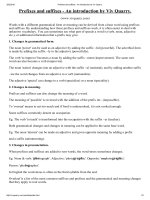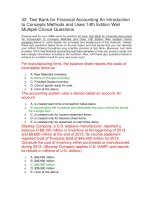Financial management an introduction by jim mcmenamin
Bạn đang xem bản rút gọn của tài liệu. Xem và tải ngay bản đầy đủ của tài liệu tại đây (5.57 MB, 956 trang )
FINANCIAL MANAGEMENT
‘A well-balanced and user-friendly introduction to a complex
discipline.’
P.A.Belk, Loughborough Business School
‘Useful examples, topical illustrations and clear discussion make this
an excellent student text—the author has adopted a practical approach
which helps the reader appreciate the importance of financial
management in the business world.’
Tony Head, Sheffield Hallam University
‘An excellent introduction to the complexities of financial management.
The book will be particularly useful for business students and others
who are coming new to the subject.’
Clive Bishop, Manchester Metropolitan University.
Financial Management is intended for use by non-specialist students taking a finance
module in a range of general business and management courses. Finance is a notoriously
difficult core subject for business undergraduates. So far the area has been dominated by
large and complex introductory texts—often from the USA—which many lecturers find
too detailed and unwieldy. This carefully developed and researched text fills this gap by
providing a short, modular, UK-focused introduction to the subject of financial
management. Quality controlled by an academic review panel, the content and approach
have been rigorously developed to answer the needs of non-finance students. Financial
Management offers the following additional features:
• a coherent and unifying model of financial management
• learning objectives, clear worked examples, in-chapter exercises with solutions, key
learning points, real-world vignettes, structured review questions with selected
answers, case studies, glossary, summary of key formulae
• user-friendly and flexible structure, most chapters can be studied as discrete
modular units
• contemporary coverage including corporate governance, ethics, Economic Value
Added (EVA), Market Value Added (MVA), stakeholder theory and the treasury
function
• Contents: Part 1: The Scope and Environment of Financial Management, 1
Introduction and Overview, 2 Key Issues in Modern Financial Management, 3 The
Financial Environment, 4 Capital Markets, Case Study 1; Part 2: The Core Concepts
in Financial Management, 5 The Time Value of Money, 6 Risk and Return—
Portfolio Theory, 7 Risk and Return—The Capital Asset Pricing Model (CAPM), 8
The Central Concept of Value, Case Study 2; Part 3: Financial Analysis and
Performance Evaluation, 9 Financial Analysis and Performance Evaluation, Case
Study 3; Part 4: Strategic Financial Decision-Making—The Investment Decision, 10
Investment Appraisal—Introduction, 11 Investment Appraisal—Risk Analysis, 12
The Cost of Capital, Case Study 4; Part 5: Strategic Financial Decision-Making—
The Financing Decision, 13 Capital Structure and Gearing, 14 Dividend Policy,
Case Study 5; Part 6: Financial Planning and Control, 15 Strategic Financial
Planning and Control, Case Study 6; Part 7: Short-Term Financial Management, 16
Short-Term Financial Planning and Control, 17 Short-term Decision-Making (1) 1,
18 Short-Term Decision-Making (2) 2, 19 Sources of Short- and Medium-Term
Financing, Case Study 7, Comprehensive Case Study 8.
Jim McMenamin is a Lecturer in Financial Management at the University of Ulster.
FINANCIAL
MANAGEMENT: AN
INTRODUCTION—TUTOR’S
GUIDE
The tutor’s guide is available to academics who adopt Financial Management: An
introduction for course use.
It includes the answers to end of chapter review questions, suggested solutions to case
studies together with indicative marketing schemes, transparency masters of key charts,
tables and diagrams, a multiple choice question bank and specimen test papers.
For more information please email:
Financial Management: An introduction
Tutor’s Guide
ISBN: 0-415-212-219
FINANCIAL
MANAGEMENT
An introduction
JIM MCMENAMIN
LONDON AND NEW YORK
First published 1999 by Routledge
11 New Fetter Lane, London EC4P 4EE
This edition published in the Taylor & Francis e-Library, 2005.
“To purchase your own copy of this or any of Taylor & Francis or Routledge’s collection
of thousands of eBooks please go to www.eBookstore.tandf.co.uk”.
Simultaneously published in the USA and Canada
by Routledge
29 West 35th Street, New York, NY 10001
© 1999 Jim McMenamin
The right of Jim McMenamin to be identified as the Author of this
Work has been asserted by him in accordance with the Copyright,
Designs and Patents Act 1988
All rights reserved. No part of this book may be reprinted or
reproduced or utilised in any form or by any electronic, mechanical,
or other means, now known or hereafter invented, including
photocopying and recording, or in any information storage or
retrieval system, without permission in writing from the publishers.
British Library Cataloguing in Publication Data
A catalogue record for this book is available from the British Library
Library of Congress Cataloguing in Publication Data
McMenamin, Jim, 1951–
Financial management: an introduction/Jim McMenamin.
p. cm.
Includes index.
1. Corporations—Finance. I. Title.
HG4026.M39 1999
658.1–dc21 98–26719
CIP
ISBN 0-203-03116-4 Master e-book ISBN
ISBN 0-203-20635-5 (Adobe e-Reader Format)
ISBN 0-415-18161-5 (hbk)
ISBN 0-415-18162-3 (pbk)
To my family
CONTENTS
List of figures
List of tables
Preface
Acknowledgements
x
xiii
xv
xxv
Part One
THE SCOPE AND ENVIRONMENT OF FINANCIAL MANAGEMENT
Overview
1 Introduction
2 Key Issues in Modern Financial Management
3 The Financial Environment
4 Capital Markets
1
2
7
42
79
121
Part Two
THE CORE CONCEPTS IN FINANCIAL MANAGEMENT
5 The Time Value of Money
6 Risk and Return—Portfolio theory
7 Risk and Return—The Capital Asset Pricing Model (CAPM)
8 The Central Concept of Value
170
172
206
236
270
Part Three
FINANCIAL ANALYSIS AND PERFORMANCE EVALUATION
9 Financial Analysis and Performance Evaluation
331
333
Part Four
STRATEGIC FINANCIAL DECISION-MAKING: The Investment
Decision
10 Investment Appraisal—Introduction
11 Investment Appraisal—Risk analysis
12 The Cost of Capital
388
390
446
472
Part Five
STRATEGIC FINANCIAL DECISION-MAKING: The Financing Decision
13 Capital Structure and Gearing
14 Dividend Policy
502
504
540
Part Six
FINANCIAL PLANNING AND CONTROL
577
15
Strategic Financial Planning and Control
578
Part Seven
SHORT-TERM FINANCIAL MANAGEMENT
16 Short-Term Financial Planning and Control
17 Short-Term Financial Decision-making (1)
18 Short-Term Financial Decision-making (2)
19 Sources of Short- and Medium-Term Financing
602
604
645
688
726
Appendices
A Financial Tables
B Solutions to Exercise Questions
C Suggested Answers to Selected Review Questions
Glossary of Key Financial Terms
Selected Equations and Formulae
Index
774
786
816
869
879
885
FIGURES
Preface
diagram
Part 1 diagram
1.1
1.2
1.3
2.1
2.2
2.3
3.1
3.2
3.3
3.4
4.1
5.1
5.2
5.3
5.4
5.5
5.6
6.1
6.2
6.3
6.4
7.1
7.2
7.3
7.4
7.5
7.6
7.7
7.8
8.1
8.2
Outline of the book
Overview of financial management
Dimensions of analysis, decision-making, planning and control
The financial management process
The expected risk-return trade-off
The structure of the finance function
Financial decisions and the value of the firm
The scope of corporate governance
The structure of financial markets
Financial institutions/intermediaries
The flow of funds
Regulatory structure of the UK financial services industry
Placing: AB Airlines plc
Time-line for investment cash flows
Investment cash flow profile
Future value-present value relationship: graph
Net present value
Annuity cash flow profile
Annuity cash flow: graph
The normal distribution
Probability distribution of returns for asset A
Probability distribution of returns for asset B
Types of correlation: two-asset portfolios
The relationship of portfolio risk to portfolio size
Derivation of beta
Characteristic lines for two different risk securities, A and B
Security market line (SML)
SML: expected return and required return
SML: inflation shift
SML: risk aversion shift
The capital market line (CML)
The fundamental asset valuation model
Bond value and required rates of return
xvii
4
10
16
34
45
45
61
83
93
111
117
133
175
176
188
189
192
192
216
218
218
225
239
242
243
252
253
255
256
261
274
8.3
8.4
Part 3 diagram
9.1
9.2
9.3
9.4
9.5
9.6
Part 4 diagram
10.1
10.2
11.1
Part 5 diagram
13.1
13.2
13.3
13.4
13.5
13.6
13.7
Part 6 diagram
15.1
15.2
Part 7 diagram
16.1
16.2
16.3
17.1
17.2
17.3
17.4
17.5
17.6
17.7
17.8
17.9
Bond values and time to maturity: graph
Cash flow time-line for variable dividend growth
The financial management process: financial analysis
Short-term funds flow
Profitability-liquidity matrix
Comparative capital structures
Pyramid of ratios
The Bermuda Triangle
Service organisations: performance matrix
The financial management process: financial decision-making
Project cash flow profile
NPV profiles: machines A and B NPVs at different discount
rates
NPV probability distribution
The financial management process: financial decision-making
Capital structure
Comparative capital structures
Traditional model of capital structure
Capital structure and the value of the firm
Effects of gearing: M&M model without taxes
Effects of gearing on value: M&M model with taxes
Effects of gearing on cost of capital: M&M model with taxes
The financial management process: financial planning and
control
Dimensions of planning and control
The management control process
The financial management process: short-term financial
management
The short-term planning framework
Cash budget: MJM Enterprises
Determination of free cash flow
Rate of current asset turnover
The operating cycle
The financing of working capital
Conservative working capital policy
Aggressive working capital policy
Moderate working capital policy
Working capital policies
Optimal level of working capital
Basic EOQ stock ordering cycles
283
285
320
331
344
345
354
359
365
373
389
407
417
457
503
505
506
507
509
513
519
520
577
580
589
603
606
617
630
651
654
657
658
660
661
662
665
670
17.10
17.11
18.1
18.2
18.3
18.4
19.1
B.1
Graphical derivation of EOQ
EOQ stock order cycle, including safety stock
Baumol cash management model
The cash cycle for a manufacturing company
The complete cash flow cycle
Miller-Orr cash management model
Normal yield curve
Project correlations
671
675
709
713
715
719
728
794
TABLES
1.1
1.2
2.1
3.1
4.1
4.2
5.1
5.2
5.3
6.1
6.2
7.1
7.2
8.1
8.2
8.3
8.4
10.1
11.1
12.1
13.1
14.1
14.2
14.3
14.4
14.5
14.6
14.7
15.1
17.1
17.2
17.3
17.4
The management continuum
Financial management versus financial accounting
Ownership of UK equities, 1994 (%)
Sources of company capital (%)
Capital issues (net) by UK listed public companies (£m)
Capital issues (net) by UK listed public companies (%)
Comparison of compounding frequencies
Present value table: the present value of £1, or PVIFr, n
Relationship between present and future value
Probability distribution of returns for assets and A and B
Portfolio risk for various two-asset combinations and correlations
Beta values of selected companies in the FTSE 100 index (September
1996)
Beta values of selected FTSE 100 companies, 1991–1996
Relationship between bond value and the required rate of return
Bond values and time to maturity
International bond issues
Palm Tree Products: range of equity valuations
Investment appraisal methods used in the Fortune 500 industrial firms
Project risk and RADR classifications
Project risk classification
Summary of M&M capital structure model
Tesco plc: financial diary, 1999
Reuters Group plc: dividend payments
Reuters Group plc: dividend payout/earnings retention ratios
Ordinary share dividend: Cadbury Schweppes
Pizza Express plc: dividend payout/earnings retention ratios
Dividend payment practice
Smooth-stream dividend policy
The planning and control continuum
Working capital composition and investment
Analysis of stockholdings
Stock turnover ratios
ABC stock classification system
11
28
57
107
123
123
181
186
187
217
230
246
247
283
284
290
308
431
461
495
521
542
543
544
546
549
563
564
581
655
667
668
17.5
18.1
18.2
18.3
18.4
18.5
19.1
19.2
19.3
19.4
19.5
A1
Stock carrying costs
Current asset composition
Debtor days
Credit scoring
Aged debtors summary report
Current asset composition
Short-term financing
Tax benefit of purchasing option
Net present value of lease option
Net present value of purchase option
Sources of short-and medium-term finance
Future value interest factor (FVIF) for £1 compounded at r per cent for n
periods
A2 Future value interest factor (FVIFA) for a £1 annuity compounded at r per
cent for n periods
A3 Present value interest factor (PVIF) for £1 discounted at r per cent for n
periods
A4 Present value interest factor (PVIFA) for £1 annuity discounted at r per
cent for n periods
669
671
689
691
694
701
705
731
750
750
751
759
774
777
780
782
PREFACE
INTENDED AUDIENCE
Financial Management: An Introduction is intended for use by undergraduate and
postgraduate students taking a finance module in a range of general business and
management-related courses.
The material in this text has already been successfully tested on undergraduate and
postgraduate students on a variety of business and management courses such as
accounting, business studies, computing, hotel and tourism, and MBAs.
Most of the students for whom this text is intended will have already acquired a basic
knowledge of financial accounting, economics and statistics, which is the only
prerequisite for using this text.
The practising manager
This book should also be of considerable value to professional, non-financial, managers
who wish to improve their managerial career prospects by gaining an understanding and
appreciation of the essential ingredients of financial management.
A SHORTER BOOK
The length of this book—it has a total of 19 chapters, which is less than other financial
management texts—reflects the changing needs of tutors and students. The shift to
shorter modularised courses means that there is less time available for both tutors and
students to cover the subject comprehensively.
A key challenge therefore has been to try and focus on the essential elements of
financial management considered of strong practical benefit to students and practising
managers. The text is designed to equip non-specialist students with the financial skills
and knowledge considered essential and of real practical benefit for a general business or
management-related career.
CONTEMPORARY COVERAGE
The text includes coverage of key contemporary features of financial management such
as corporate governance, ethics, Economic Value Added (EVA), Market Value Added
(MVA), stakeholder theory and the treasury function.
ORGANISATION AND STRUCTURE
Coherent model
This book has been structured with two particular goals in mind. The primary goal is to
offer students of financial management a coherent model around which they can build
knowledge and understanding of the subject. Providing such a model allows them to
visualise where relevant aspects of financial management fit together in a logical and
progressive framework.
Students of financial management, particularly non-specialist students, often perceive
the subject as a diverse collection of seemingly unrelated concepts, techniques and
theories without any apparent overall structure. Consequently, they find it difficult to fit
these various pieces together into a coherent model or conceptual framework.
This book has been designed to overcome this difficulty by providing a unifying and
coherent model of the financial management process, one which will help students
visualise essential financial concepts and their interrelationships. By following this model
students will begin to appreciate and understand how and where apparently unrelated
concepts and techniques fit into the overall context of financial management.
There is also the advantage that by structuring our approach around such a
management model, the basic constructs will already be familiar to many students and
managers.
Modular structure
The second goal, bearing in mind the shift in most universities and colleges to shorter
modularised courses, is to offer tutors a logical and progressive, yet flexible, modular
teaching framework. While the essential structure progresses in a logical sequence, this
does not imply rigidity: most chapters can be studied as discrete modular units to suit an
individual tutor’s objectives. Hopefully this structure will provide flexibility for tutors
teaching on courses of varying length and intensity.
With these goals in mind the book is organised into seven parts which are outlined as
follows.
PART 1 THE SCOPE AND ENVIRONMENT
OF FINANCIAL MANAGEMENT
Part 1, which consists of an Overview of financial management and Chapters 1 through 4,
addresses the broad scope of financial management and presents an analysis of the
financial environment in which the business firm operates. The opening Overview
highlights the key concepts of financial management through the medium of a mini
business scenario. Chapter 1 provides the essential introduction to the goals, concepts,
techniques and processes of financial management, and emphasises the principal goal of
financial management as the maximisation of shareholder wealth.
Chapter 2 explains the role of the financial manager and treasury management. The
chapter proceeds to explore the impact and influence of the key issues of agency and
stakeholder theory, corporate governance and ethics on modern financial management.
These are issues which are often described as limiting or constraining influences on the
shareholder wealth maximisation objective of the firm. However they are described, they
are matters of key relevance to the modern financial manager and their impact is fully
examined.
PART 1
The Scope and Environment of Financial Management
Overview
Chapter 1 Introduction
Chapter 2 Key Issues in Modern Financial Management
Chapter 3 The Financial Environment
Chapter 4 Capital Markets
PART 2
The Core Concepts in Financial Management
Chapter 5 The Time Value of Money
Chapter 6 Risk and Return—Portfolio Theory
Chapter 7 Risk and Return—The Capital Asset Pricing Model (CAPM)
Chapter 8 The Central Concept of Value
PART 3
Financial Analysis and Performance Evaluation
Chapter 9 Financial Analysis and Performance Evaluation
PART 4
Strategic Financial Decision-making—The Investment Decision
Chapter 10 Investment Appraisal—Introduction
Chapter 11 Investment Appraisal—Risk Analysis
Chapter 12 The Cost of Capital
PART 5
Strategic Financial Decision-making—The Financing Decision
Chapter 13 Capital Structure and Gearing
Chapter 14 Dividend Policy
PART 6
Strategic Financial Planning and Control
Chapter 15 Strategic Financial Planning and Control
PART 7
Short-Term Financial Management
Chapter 16 Short-Term Financial Planning and Control
Chapter 17 Short-Term Financial Decision Making—1
Chapter 18 Short-Term Financial Decison Making—2
Chapter 19 Sources of Short- and Medium-Term Financing
Preface diagram Outline of the book
Neither the financial manager nor the firm operates in a self-contained environment.
Chapter 3 explores the financial environment—which is part of the wider economic
environment within which the business firm operates—not only in a domestic context but
also internationally. The chapter provides an analysis of the role of financial markets,
financial institutions, and financial instruments, the three main constituents of the
financial environment, and explores how their roles are changing in today’s global
environment.
Chapter 4 deals in more depth with capital markets, where companies’ long-term
securities such as shares and bonds are traded and reviews the role of capital markets as a
source of long-term capital for the firm. The role of the London Stock Exchange is
emphasised. The chapter devotes some time to discussing the key issue of financial
market efficiency and its implications for the financial manager. The problems
encountered by small firms in raising finance in the capital markets are also examined.
PART 2 THE CORE CONCEPTS IN
FINANCIAL MANAGEMENT
Part 2 contains Chapters 5 through 8 and deals with the core concepts in financial
management, time value of money, risk and return, and value. These key concepts form
the essential conceptual and technical building blocks for the rest of the text. Having
examined the role of financial markets in Part 1, Part 2 proceeds to demonstrate how the
markets value or price a firm’s securities. As the goal of the firm is the maximisation of
shareholder wealth this is reflected by the value or price of a company’s shares in the
capital markets at a point in time.
Chapter 5 presents comprehensive treatment of the time value of money. It explains
how the timing of cash flows affects their value and deals with the concepts of future
value, present value, annuities, perpetuities and net present value.
Chapters 6 and 7 together cover risk and return. Chapter 6 first explains the
determination of risk and return and proceeds to analyse risk and return in the context of
portfolio theory. The essential statistical techniques are briefly reviewed. Chapter 7
develops the analysis of risk by introducing the Capital Asset Pricing Model (CAPM), a
key aspect of modern financial management, and explains how the CAPM links
systematic risk to return to determine the price of a firm’s securities.
Chapter 8 deals with the central financial management concept of value. The chapter
integrates the key concepts of time value of money and risk and return into the
fundamental asset valuation framework and examines the different approaches to asset
valuation including more recent developments such as Shareholder Value Analysis
(SVA), Economic Value Added (EVA) and Market Value Added (MVA).
PART 3 FINANCIAL ANALYSIS AND
PERFORMANCE EVALUATION
Parts 1 and 2 lay the essential introductory background and conceptual foundation upon
which the rest of the text builds. In Part 3 we begin to apply our fundamental model of
the financial management process. The starting point for our model is Chapter 9 which
introduces an essential skill for any financial manager, namely financial analysis and
performance evaluation.
Financial analysis will help the financial manager evaluate the firm’s current financial
strengths and weaknesses and assess the effects of past investment and financing
decisions on the firm’s returns and risk and thus its value. It is only after developing a
sound understanding of a company’s current financial position that effective future
financial decisions and plans aimed at maximising shareholder wealth can be made.
This chapter also discusses the distinctions and difficulties of performance
measurement in service organisations and in not-for-profit organisations together with an
analysis of corporate failure.
PART 4 STRATEGIC FINANCIAL
DECISION-MAKING
The investment decision
While financial analysis is essentially a retrospective exercise evaluating the effects of
past decisions, Part 4 in contrast is forward-looking and deals with the second stage in the
financial management process, that is, financial decision-making. It examines the critical
financial decision for any firm—the strategic investment decision (SID). As it is the
quality of a firm’s strategic investment decisions which is critical in deciding its future
and in determining the wealth of its shareholders, it is vital that such decisions are
properly appraised and evaluated before being implemented.
Chapter 10 introduces the concept of investment appraisal and explains its essential
tools and techniques mainly under conditions of certainty. The role of net present value
(NPV), introduced in Chapter 5, in evaluating investment projects is emphasised and the
influence of non-financial considerations in the investment decision-making process is
reviewed. This chapter also examines the operation of investment appraisal in the public
sector.
Chapter 11 develops and refines the approach to investment decision-making by
introducing risk and explaining the main techniques of investment risk analysis.
Chapter 12 explores the derivation of a firm’s cost of capital, which is the rate of
return used to discount the firm’s investment cash flows. The cost of capital links the
firm’s strategic investment and financing decisions and its accurate determination is a
critical factor in the investment appraisal process.
PART 5 STRATEGIC FINANCIAL
DECISION-MAKING
The financing decision
Part 5 develops financial decision-making by examining the nature of the firm’s strategic
financing decisions. The quality of the firm’s investment decisions will have a direct
impact on the value of the firm and the wealth of its shareholders. However, the
connection between financing decisions and the value of the firm is less clear. The key
issues of capital structure and dividend relevance are examined.
Chapter 13 deals with the firm’s long-term, strategic financing arrangements. It
explores the determination and relevance of a firm’s long-term capital structure and
presents an analysis of gearing.
Chapter 14 explores the firm’s dividend policy, which is a major element in the firm’s
strategic financing decision, and examines its relevance to corporate value.
PART 6 STRATEGIC FINANCIAL
PLANNING AND CONTROL
Part 6 progresses to examine the final planning and control stages of the financial
management process, mainly from a strategic perspective. When strategic investment
decisions are made, they need to be implemented effectively if they are to produce the
desired results, that is, an increase in shareholder value.
Successful implementation requires effective financial planning and control systems to
be in place and these are discussed in Chapter 15 . Financial planning maps out the future
financial direction of the firm and financial control ensures that the directions on the
financial map are being followed. The role of computer-based modelling in financial
planning and decision-making is also examined.
PART 7 SHORT-TERM FINANCIAL
MANAGEMENT
In Part 7 we change our focus from strategic to operational financial management. We
move from financial decision-making in the strategic context to financial decisionmaking in the operational context. Strategic investment and financing decisions affect the
structure of a firm’s long-term (fixed) assets, its long-term liabilities and its long-term
cash flows: operational investment and financing decisions affect the structure of the
firm’s short-term (current) assets, liabilities and cash flows.
In the context of our overarching financial management model, short-term financial
management emphasises financial decision-making, planning and control at the
operational level of managing the firm’s short-term assets, short-term liabilities and cash
flows—an aspect of financial management which is vital for a firm’s survival. As the
focus of short-term financial management is on the firm’s short-term or current assets and
liabilities it is often referred to as working capital management.
Chapter 16 relates the concepts of financial planning introduced in Chapter 15 to the
management of the firm’s financial resources in the short term. The chapter explores the
two key dimensions of short-term financial planning—cash planning and profit planning.
Chapter 17 develops the analysis of short-term financial management by examining
the firm’s management of its working capital and its short-term investment and financing
decisions. The chapter progresses to specifically examine the management of the key
short-term asset of stocks.
Chapter 18 extends the coverage of working capital management to analyse the
management of debtors and cash. The management of debtors includes an examination of
credit management and a review of factoring and invoice discounting. The management
of cash includes an analysis of cash management models and the cash cycle. Aspects of
computerised and international cash management are also reviewed.
Chapter 19 reviews the management of the firm’s current liabilities and evaluates the
main sources of short- and medium-term business finance.
Pedagogical features
This book incorporates a number of distinctive pedagogical features designed to facilitate
the student learning and teaching processes.
Chapter outline
Each chapter begins with a brief outline. This enables students and tutors to see at a
glance the main topics covered in the chapter.
Learning objectives
Each chapter also opens with a set of clear and specific learning objectives. These will
serve as benchmarks against which students can test their understanding and progress.
They will also serve as a framework around which tutors can structure lectures and
seminars.
Chapter overview
At the beginning of each chapter the student is provided with a short overview of the
concepts and techniques to be covered in the chapter, relating them to their overall
financial management context.
Key terms
Key terms are highlighted in bold type when they are introduced in the text. A glossary
of key financial terms is also provided.
Worked examples
Worked examples demonstrating numerate topics are clearly presented where relevant.
In-chapter exercises
In-chapter exercises are designed to stimulate student participation and activity. They
allow students to consolidate their understanding of key concepts and techniques before
progressing. Solutions to all in-chapter exercises are provided in Appendix B.
Key learning points
Key learning points are identified and emphasised where appropriate. These have been
distilled from the text to help students identify more quickly the key point(s) to learn and
understand in a chapter or section.
Chapter recap
A recap at the end of each chapter enables students to quickly review and summarise
the key topics covered in the chapter.
Further reading
Each chapter concludes with a selected further reading list for students wishing to
explore chapter topics in more depth.
References
An appropriate reference section is also provided. Combined with the selected further
reading these will assist students in preparing assignments, practical projects and
dissertations. Often the original articles referred to offer clearer insights into the subject
matter than the summaries, condensations and interpretations of the same articles
provided by subsequent authors.
Review questions
At the end of every chapter there is a structured series of review questions designed to
test the student’s understanding of the main concepts and techniques presented in the
chapter. The review questions include concept review questions, which are mainly
theoretical and discursive in nature, and allow students to test their understanding of the
basic concepts and principles presented in the chapter. The concept review questions are
complemented by practice and test questions where relevant, including questions from
past professional examination papers. Solutions to selected review questions are provided
in Appendix C. Solutions to all other review questions and case studies are provided in
the tutor’s guide. These review questions can form the basis for seminars, tutorials and
student assessment exercises.
Practical projects
Suggestions are given at the end of relevant chapters for student-based practical
projects. The projects are designed to develop the student’s understanding of the practical
application of the concepts and techniques covered in a particular chapter, or series of
chapters. These projects can be used as individual or group-based student assessment
exercises.
Case studies
In addition to review questions and practical project suggestions, a number of
challenging integrative case studies are included at the end of relevant parts of the text.
This blend of review questions, suggested practical projects, and case studies offers the
tutor a very flexible range of alternative material for use in student assignments, projects,
tutorials and seminars.
Relating theory to practice
Concepts and ideas are illustrated with numerous real-world examples, illustrations and
references. In this connection vignettes are integrated into the text in the form of a short
case in point. These are designed to help students see, in close proximity to the theory,
the practical relevance, application, or misapplication, of key concepts, topics and
themes.
Glossary of key financial terms
To assist students develop their financial literacy and come to terms with the language
of finance more quickly, a glossary of the key financial terms is included at the end of the
book.
Selected equations and formulae
For ease of reference and familiarisation, a summary of the key equations and formulae
is provided at the end of the text.
TEACHING AIDS
A tutor’s guide is available for adopters of the text. The guide includes answers to endof-chapter review questions, suggested solutions to case studies together with indicative
marking schemes, transparency masters of key charts, tables and diagrams, a bank of
additional ‘quick test’ multiple choice questions and test papers.
SUGGESTIONS FOR IMPROVEMENT
The author and publisher would welcome comments, observations and suggestions for
improvement from lecturers, practising managers and students who have used this text.
Kindly forward comments and suggestions to the publisher at the address given in the
text.









